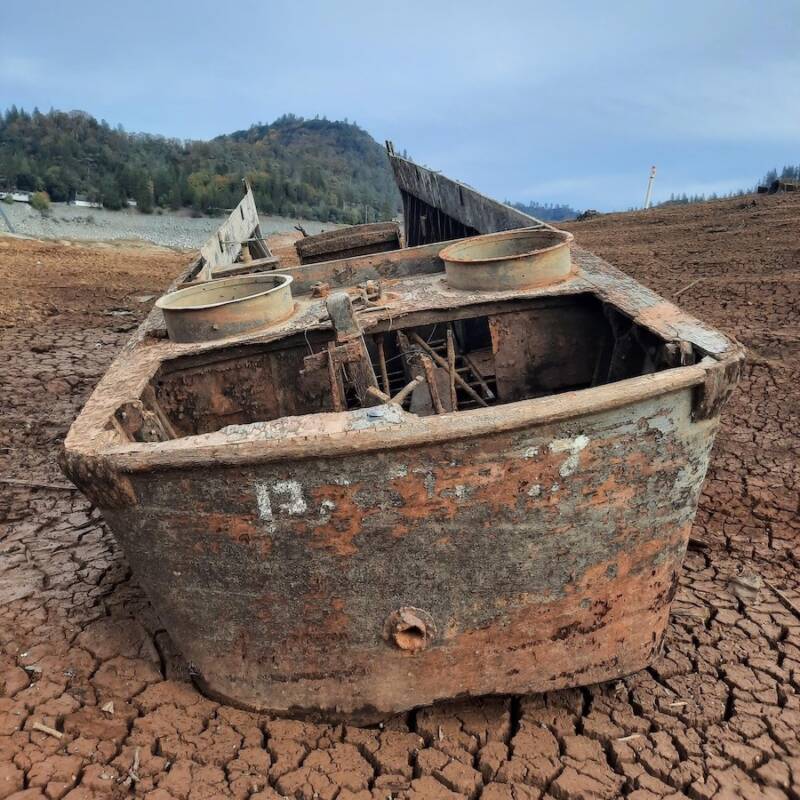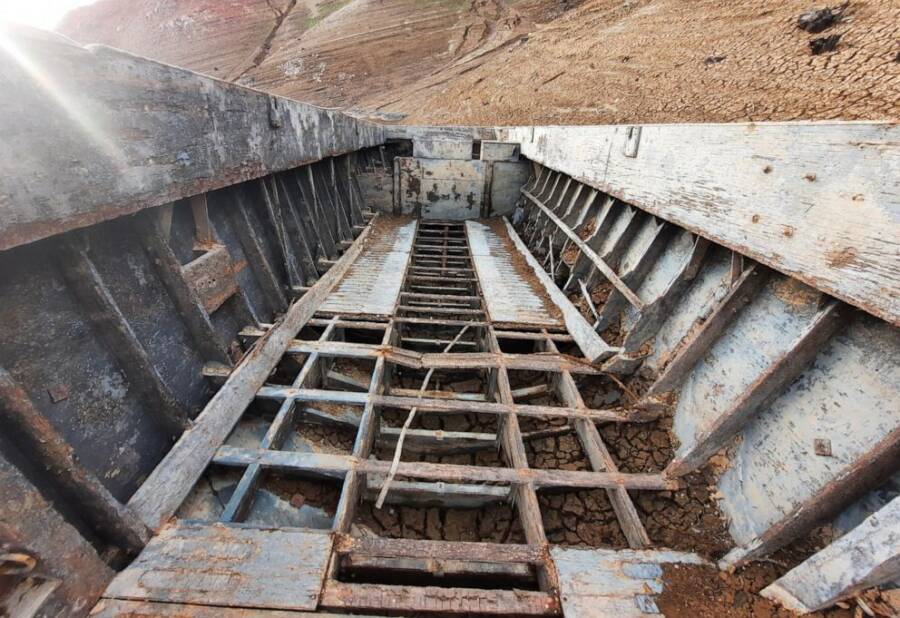This Higgins boat was used for amphibious landings and has a well-documented military history — but it remains unclear how it wound up at the bottom of Lake Shasta.

U.S. Forest ServiceRoughly 23,000 Higgins boats were made during World War II, and many historians claim they changed the way that naval battles were fought.
As many regions in the western United States face ongoing droughts, a number of objects that once lurked beneath the surfaces of lakes and rivers are revealing themselves to the world. And now, an old, rusted boat used during World War II has inexplicably been found in a lake in Northern California.
As The New York Times reports, there had long been rumors about a vessel at the bottom of Lake Shasta. But those reports remained largely unsubstantiated until last autumn, when a volunteer firefighter and military vehicle collector named James Dunsdon set out to find the boat.
“It just came over the horizon like a ghost,” Dunsdon told the Times. “There it was with original World War II paint and timbers and steel and in the position with the ramp down.”
The 36-foot landing craft was surprisingly well-preserved, and looked as if it sank while making a beach landing. Experts are now referring to the old Higgins vessel as the “ghost boat,” and while the discovery is itself fascinating, how the boat came to be in Lake Shasta in the first place remains a mystery.
According to the Shasta-Trinity National Forest, the boat, which is marked “31-17,” was assigned to the USS Monrovia attack transport in the summer of 1943. It carried U.S. troops to battle during the Allied invasion of Sicily, and served as General George Patton’s headquarters during the invasion.
Later that year, the boat was deployed in the Battle of Tarawa in the Pacific. Experts believe the ship sank in shallow waters during that battle, but was later salvaged, and that at one point in time, Gen. Dwight D. Eisenhower himself stood aboard the vessel. The boat then went on to play a role in D-Day invasions, according to Shasta-Trinity National Forest representatives.

U.S. Forest ServiceHiggins boats, outfitted with guns and a bow ramp, were designed to carry troops across shallow waters.
Once the boat is in stable enough condition to transport, it will be displayed in the Nebraska National Guard Museum, located about 50 miles south of Columbus, Nebraska — the birthplace of Andrew Jackson Higgins, the boat’s namesake and designer.
Gerald Meyer, executive director of the museum, is part of the ongoing restoration and preservation of the “ghost boat.” He hopes that the publicity surrounding the find will help researchers solve the mystery of how the boat wound up in Lake Shasta.
“Someone has to know,” Meyer told the Times. “Someone is going to say: ‘I know. I remember Bob bought that boat back in ’54.’ But that person has yet to be found.”

U.S. Forest ServiceIn recent years, a few Higgins boats have reappeared in parts of the U.S., including one found in a barn in the Midwest.
Jerry E. Strahan, author of Andrew Jackson Higgins and the Boats that Won World War II, told the Times that the condition of the Lake Shasta ghost boat is particularly remarkable because Higgins boats were constructed out of mahogany plywood.
“Wooden boats weren’t meant to last that long,” Strahan said. “But I’d imagine that being underwater in a cold-water lake, away from oxygen, allowed it to survive.”
According to ABC News, this isn’t the only Higgins boat to have been revealed in a drought-struck lake this year.
In July, a Higgins boat surfaced on the waters of Lake Mead in Nebraska, just months after multiple bodies were discovered in Lake Mead thanks to its dropping water levels.
As curious as discoveries like this are, they are also a stark reminder of the impact of climate change on the natural environment. Federal data shows that Shasta County, for instance, is experiencing its driest year to date based on data from the last 128 years.
In fact, all over the world, severe droughts are revealing long-lost artifacts, relics, and even entire towns — but is the environmental cost worth it?
After learning about the discovery of this Higgins boat, check out these photos from D-Day. Then, explore the history of the Salton Sea, the now-toxic abandoned California lake that once brought in flocks of tourists.





